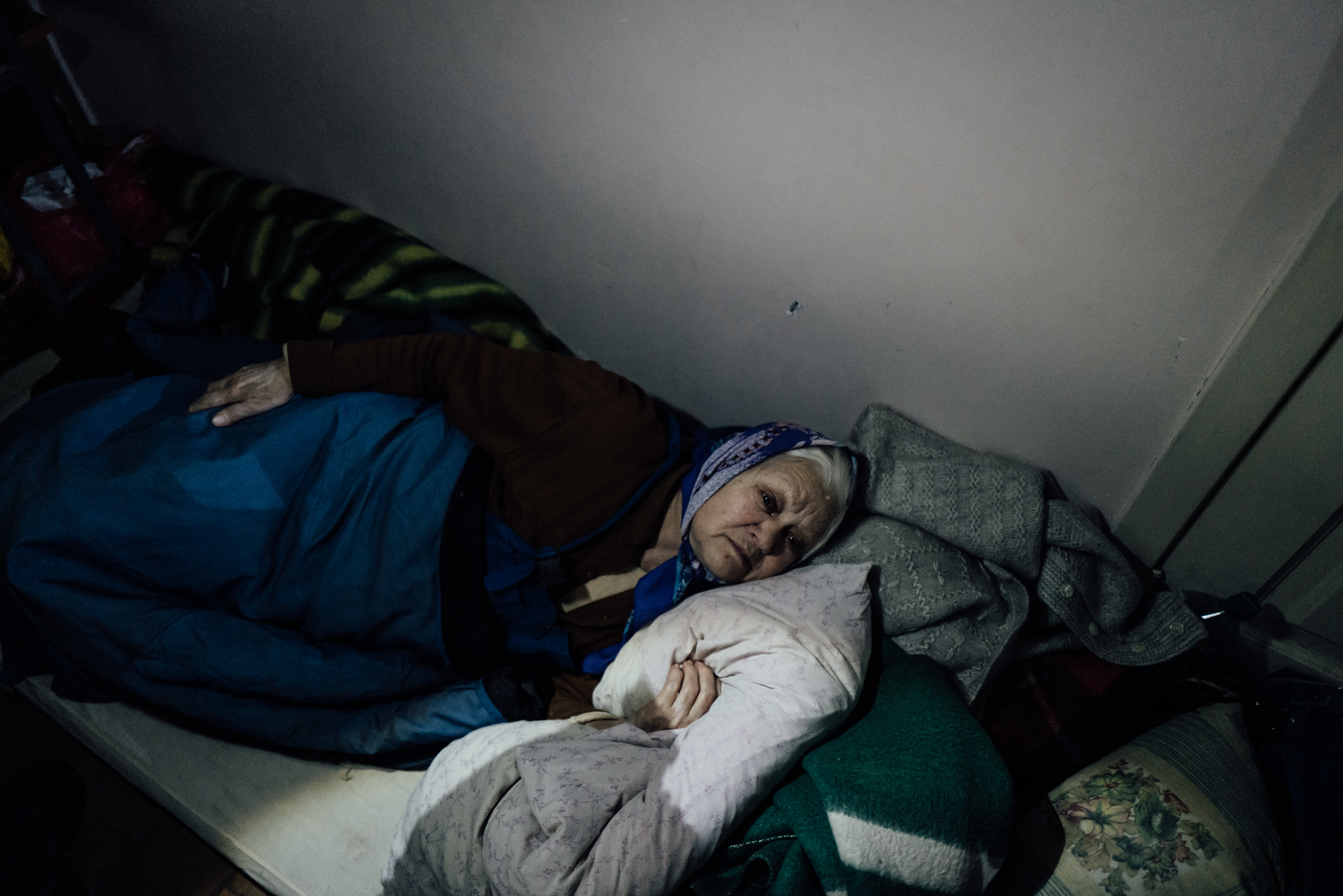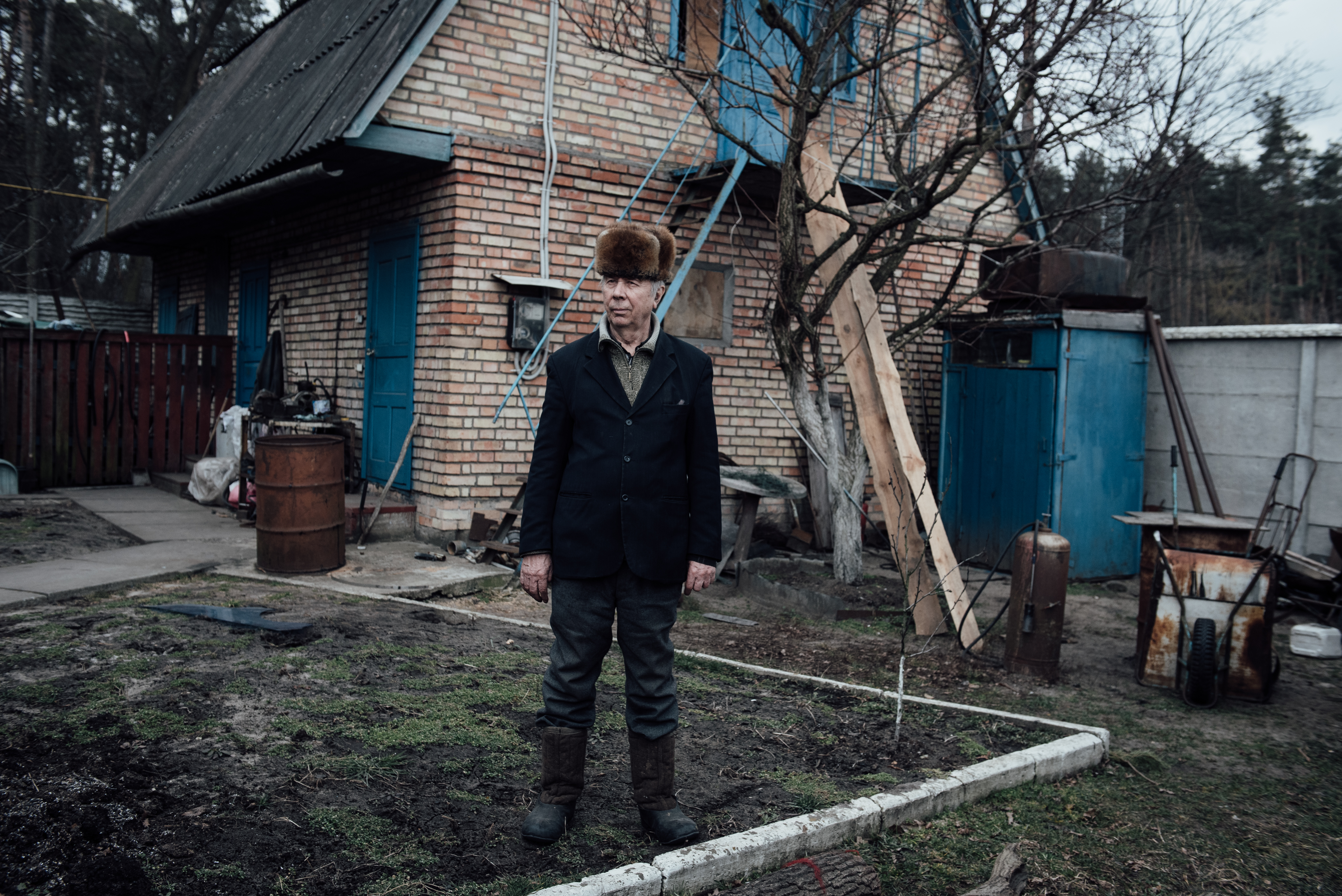This article originally appeared on VICE France. Content warning: This piece contains graphic images which some may find upsetting.
“There are 300 photographers in a refugee camp, 100 on the frontline and 25 where the bombs are falling,” said war photographer Patrick Chauvel in a recent interview about his work in Ukraine with the French daily Le Monde.
Videos by VICE
One of the photojournalists working out of wartorn country was 51-year-old American journalist Brent Renaud. On the 13th of March, Renaud was killed in Irpin, a suburb north-west of Kyiv and one of the main battlefronts in the battle for Kyiv. Thanks to his and other journalists’ work, Irpin made headlines with images of civilians fleeing across the city’s main bridge.
French photojournalist Adrien Vautier was out in Irpin covering the attack too. He saw scenes of indescribable violence and, more than once, brushed up against life-threatening danger. “The Russians are a few streets away” was the first thing he said to me when we first spoke on the phone in mid-March.
Since then, Russian forces have retreated from Irpin and from the positions they held in the neighbouring town of Bucha. After leaving Kyiv, Russia says that its efforts will now focus on the east of the country.
Over the past weeks, the horrors they’ve left behind have become clear to the rest of the world. But for a while, Bucha – like many other occupied regions in Ukraine – was a black box, with no news of what was happening on the ground coming out. All that we knew was reported from Irpin, on the Ukrainian side of the front, by war journalists and photographers like Vautier, who got up and close to danger to establish the facts on the ground and relay powerful images that have moved the world.
Vautier’s work is essential, but it comes at a high cost, both in terms of his physical safety and of the long-lasting effects on his mental health. Now back in France, he reflects on what he saw while working in Ukraine.

VICE: Hey Adrien. Can you tell me about this photo of the Ukrainian soldier? Adrien Vautier: Irpin is a town 20 kilometres from Kyiv. The bridge is right at the beginning of the city. It was destroyed by Ukrainian forces in early March to slow down Russian troops, but unfortunately, it also made the evacuation of civilians and injured people much harder. In this photo, I was coming back from the bridge when I looked up and saw this soldier in this apocalyptic scene. By the way, those aren’t clouds, it’s smoke from the bombings in the neighbouring town of Hostomel.
When I got to the bridge, there were already a lot of journalists in the area. What stuck with me was how calm the civilians remained. Nobody was rushing, they let disabled and older people through, even though bombs were falling all around them. Before long, I was holding out my hand instead of my camera.

**Why did you decide to go deeper into the city?
**I had to look for other stories. That required more time and risks. I ended up continuing forward at the first roundabout, until I reached the entire town and the front line. The Russian army was only a few metres away. Things were very hard there.
What was the situation like in the city centre?
It was urban warfare with lots of civilian deaths. There were brains splattered across pavements and bodies all over the parks in the city.

**Can you tell me about the hospital you saaw?
**I had been in Irpin for several days when I decided to go there with another journalist. The hospital had seen some heavy fighting. In fact, the Russians had taken it, then the Ukrainians managed to get it back. When we went up to the different floors inside the building, we saw trails of blood everywhere. If you followed them, they led to the basement. The smell of blood was so intense.
**How were the Ukrainian people who stayed behind?
**A sort of resilience had taken hold of the city. I took photos of civilians hiding in basements, their eyes looked lost and their hands were trembling. They saw unimaginable things. Some of the inhabitants who were still there, especially Ukrainian volunteers, thought of themselves as already dead. It’s a trauma that will never go away. People were nervous wrecks. And among all of that, there were people still trying to escape.

**This photo [the lede image in the article] is very powerful. The man looks completely lost, as well as injured.
**I’m still haunted by this man. He arrived on his own, completely disorientated, running around without knowing what to do. He was in a state of shock. The physical violence is very present in this photo. I won’t forget it.
**The picture below was taken right at the front line, right?
**Yes, that’s the crossroad. Behind it is the town of Bucha, where the Russian troops were. I was on the Ukrainian side. There was a lot of fighting there, it was the most dangerous area.

**Taking that photo was risky. Why did you decide to go ahead anyway?
**When I was there the day before, the area seemed quiet – even though the Russians were at the end of the street. People were telling me to watch out because there were snipers. So, when you’re there, you don’t stay long.
I went out to take pictures of civilians walking next to a dead body [Editor’s note: We have not published this photo due to its graphic nature] and I was very unprotected. In the distance, you could see Russian positions and I was in the middle of the street, completely uncovered. Anything could have happened at any moment. I tried to be careful, I planned everything in advance to expose myself as little as possible. I stayed there for 20 minutes and no bullets were fired.
**How do you stay calm under so much pressure?
**When you’re in it, there’s no time to think about the risks. If you lose concentration, that’s when you make a mistake. You’ll turn left instead of right and find yourself facing a Russian battalion. You see something horrific then move onto the next thing. We’re constantly on the move. The goal is not to die. I don’t want to die for my job.
**Did you form a connection with anyone in the city?
**Igor [pictured below], who transported me into Irpin twice. He was one of the civilians who was going back and forth between the city and the bridge to evacuate people. We got in his car and he dropped us off in the city.

**What made you bond with him?
**From the start, Igor told us he wanted to help people escape. He was traumatised, he had seen very serious things. These are people we cannot forget, these everyday heroes that the war will not remember. I’m interested in these stories, people who put their lives in danger with no equipment to save others. I have a lot of respect for him.

**Can you tell me more about the man burying bodies in the picture above?
**His name is Andriy. He’s a volunteer at the Territorial Defence Forces in Irpin and a former Donbas soldier. He’s been collecting bodies all over the city and burying them in the woods next to the hospital, until they can receive a proper burial in the cemetery, which at the time was under Russian control. People need to see these images so they won’t forget.

**Who is this man in the picture above?
**Anatoli, aged 73. He lives in Romanivka, a village near a bridge leading to Kyiv. He didn’t want to leave even though his village was a base for the Ukrainian army. He was ready to fight until the end. The difficulty with evacuations is that there are many elderly people who are isolated and can’t move. In Irpin, a lot of them said they preferred to stay because they felt too old to rebuild a life somewhere else. They said they’d rather die there.

**Are there moments when you think, ‘I’ve had enough’?
**When you’re in a conflict zone, you’re working seven days a week. You sleep and eat very little. You’re stressed by the workload and worried something might happen.
I work for several media organisations, so I also have to manage everyone’s requests and expectations. After four or five weeks, I have to go home. I can’t handle it anymore.
I don’t have a strong personal attachment to the city, so I can be somewhat emotionally distant, unlike Ukrainians from Irpin. But things get complicated when you come back. These images stay etched on your mind.
**Is it hard to go back to France and lead a “normal” life?
**After going home, I’m pretty much dead. I need to decompress and not to see too many people. I have a therapist in France. I used to go to therapy even before being a war reporter, but now it really helps me cope. I can’t tell my partner everything, it’s tough for her.
I feel guilty for putting my family through all this stress and the fear that something might happen to me. My parents are always scared. Social media helps me keep in touch and reassure my loved ones. I’m not completely disconnected, but it’s my job. I know that everyone is emotionally involved.
Does it get easier with time?
At the beginning, I couldn’t mentally get away from the war zone. I was angry seeing the world around me so calm while a conflict was raging where I’d just come from. I thought it was unfair. With time, though, my perspective changed. We might all be on the same planet, but we aren’t living in the same world. You can’t blame people for living their lives even though there’s a war 1,000 kilometres away. That’s why I go back to my usual routine, I walk around and free my mind.
Scroll down to see more of Vautier’s photos:










